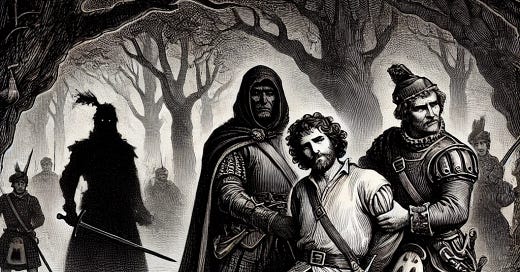The Betrayal and Capture of William Wallace
Sir William Wallace, the legendary Scottish hero, is celebrated for his unyielding resistance against English rule and his pivotal role in the Scottish struggle for independence. However, his storied life met a tragic and treacherous end. The betrayal and capture of William Wallace is one of the most poignant and dramatic episodes in the annals of Scottish history, marking the end of a significant chapter in the fight for freedom.
Rising Tensions and Wallace’s Resistance
By the early 1300s, Wallace's guerrilla warfare tactics had made him a thorn in the side of the English. His hit-and-run strategies, deep knowledge of the terrain, and ability to inspire his followers had led to numerous victories and a sustained campaign of resistance. Despite setbacks, including the disastrous Battle of Falkirk in 1298, Wallace remained a symbol of defiance and hope for the Scottish people.
Wallace's relentless efforts to liberate Scotland from English rule made him a target for King Edward I of England. Edward, determined to crush Scottish resistance, saw Wallace's capture as crucial to asserting his dominance over Scotland. Despite losing formal power and the title of Guardian of Scotland after Falkirk, Wallace continued to wage a guerrilla war, refusing to accept English rule.
The Betrayal by Sir John Menteith
The betrayal of Wallace is shrouded in a mixture of historical fact and legend. It is widely believed that Sir John Menteith, a Scottish knight, played a pivotal role in Wallace's capture. Menteith, who had initially appeared to support the Scottish cause, ultimately sided with the English, perhaps swayed by promises of reward or coerced by circumstances.
Wallace had sought refuge in a small house at Robroyston, near Glasgow, while waiting for an expected rendezvous with Robert the Bruce. Unbeknownst to him, his movements were being closely monitored. On the night of August 5, 1305, Wallace's location was betrayed to the English forces by a spy, leading to his capture under cover of darkness.
The Capture
As Wallace slept, the spy removed his bugle and weapons, signaling the English soldiers to enter. They quickly seized and executed Wallace's loyal companion, Kerle. Awoken by the commotion, Wallace instinctively reached for his weapons, only to find them missing. Undeterred, he grabbed a large piece of oak and fiercely resisted his captors, killing two of them in the struggle.
Despite his formidable defense, Wallace was outnumbered and eventually overpowered. Menteith, exploiting Wallace's momentary disorientation, persuaded him to surrender, falsely assuring him that he would be treated with leniency if he accompanied him to Dumbarton Castle. Trusting in his old comrade’s word, Wallace allowed himself to be taken into custody.
The Journey to London
Wallace's capture sent shockwaves through both Scotland and England. As he was transported to London, the news of his imprisonment spread rapidly, drawing crowds eager to glimpse the famed Scottish warrior. At Carlisle, he was held overnight in a tower that would later bear his name, a testament to the enduring impact of his legacy.
The journey to London was marked by public spectacle, with Wallace paraded through towns and cities, a grim trophy of English triumph. Upon arriving in London, he was lodged in the house of a citizen in Fenchurch Street, where the final preparations for his trial were made.
The Mock Trial
The trial of William Wallace was a mockery of justice. Held on August 23, 1305, in Westminster Hall, it was a foregone conclusion orchestrated to legitimize his execution. Wallace was charged with treason, despite his defense that he had never sworn allegiance to the English crown and thus could not be a traitor. He openly admitted to the charges of fighting against the English and burning their towns, stating that his actions were in defense of Scotland’s liberty.
Despite his eloquent and defiant defense, Wallace was condemned to a brutal execution. The sentence was designed to serve as both punishment and a stark warning to others who might dare to challenge English authority.
Execution and Legacy
On August 23, 1305, Wallace was dragged through the streets of London to Smithfield, where he faced his execution with unyielding courage. Denied the right to confess to a priest initially, it was only through the intervention of the Archbishop of Canterbury that Wallace was granted a final absolution. His execution was as brutal as it was public: he was hanged, drawn, and quartered, his body parts displayed across England and Scotland as a grim deterrent to others.
Despite the gruesome end, Wallace's legacy was cemented as a martyr for Scottish independence. His life and death inspired countless Scots to continue the fight for freedom, and his story became a symbol of resistance against tyranny. The betrayal and capture of William Wallace, far from quelling the spirit of the Scots, ignited a renewed fervor for independence, leading ultimately to the victories of Robert the Bruce and the eventual recognition of Scottish sovereignty.
William Wallace remains an enduring figure in Scottish history, emblematic of the struggle for freedom and the resilience of the human spirit against oppression. His betrayal and capture, while a tragic episode, underscore the profound impact of his life and the enduring power of his legacy.





